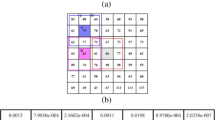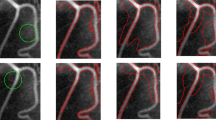Abstract
Image segmentation is a crucial step in image processing, especially for medical images. However, the existence of partial volume effect, noise and other artifacts makes this problem much more complex. Fuzzy c-means (FCM), as an effective tool to deal with partial volume effect, cannot deal with noise and other artifacts. In this paper, one modified FCM algorithm is proposed to solve the above problems, which includes three main steps: (1) peak detection is used to initialize cluster centers, which can make the initial centers close to the final ones and in turn decrease the number of iterations; (2) fuzzy clustering incorporating spatial information is implemented, which can make the algorithm robust to image artifacts; (3) the segmentation results are refined further by detecting and reallocating the misclassified pixels. Experiments are performed on both synthetic and medical images, and the results show that our proposed algorithm is more effective and reliable than other FCM-based algorithms.







Similar content being viewed by others
References
Ahmed MN, Yamany SM, Mohamed N, Farag AA, Moriarty T (2002) A modified fuzzy c-mean algorithm for bias field estimation and segmentation of MRI data. IEEE Trans Med Imaging 21(3):193–199
Benaichouche AN, Oulhadj H, Siarry P (2013) Improved spatial fuzzy c-means clustering for image segmentation using PSO initialization, Mahalanobis distance and post-segmentation correction. Digit Signal Process 23(5):1390–1400. doi:10.1016/j.dsp.2013.07.005
Bezdek JC (1974) Cluster validity with fuzzy sets. J Cybern 3(3):58–73
Bezdek JC (1981) Pattern recognition with fuzzy objective function algorithms. Kluwer Academic Publishers, Norwell
Cocosco C, Kollokian V, Kwan RKS, Pike GB, Evans A (1997) Brainweb: online interface to a 3D MRI simulated brain database. Neuroimage 5(4):S425
Cai W, Chen S, Zhang D (2007) Fast and robust fuzzy c-means clustering algorithms incorporating local information for image segmentation. Pattern Recognit 40:825–838
Chen S, Zhang D (2004) Robust image segmentation using FCM with spatial constraints based on new kernel-induced distance measure. IEEE Trans Syst Man Cybern Part B Cybern 34:1907–1916
Chuang KS, Tzeng HL, Chen S, Wu J, Chen TJ (2006) Fuzzy c-means clustering with spatial information for image segmentation. Comput Med Imaging Graph 30:9–15
Elmazi D, Kulla E, Matsuo K, Oda T, Spaho E, Barolli L (2015) A mobility-aware fuzzy-based system for actor selection in wireless sensor–actor networks. J High Speed Netw 21(1):15–25
Graves D, Pedrycz W (2010) Kernel-based fuzzy clustering and fuzzy clustering: a comparative experimental study. Fuzzy Sets Syst 161:522–543
Guo Q, Zhang C, Zhang Y, Liu H (2015) An efficient SVD-based method for image denoising. IEEE Trans Circuits Syst Video Technol. doi:10.1109/TCSVT.2015.2416631
Ji Z, Sun Q, Xia D (2010) A modified possibilistic fuzzy c-means clustering algorithm for bias field estimation and segmentation of brain MR image. Comput Med Imaging Graph 35:383–397
Ji Z, Sun Q, Xia D (2011) A framework with modified fast FCM for brain MR images segmentation. Pattern Recognit 44:999–1013
Kannan SR, Ramathilagam S, Devi R, Sathya A (2011) Robust kernel FCM in segmentation of breast medical images. Expert Syst Appl 38:4382–4389
Krinidis S, Chatzis V (2010) A robust fuzzy local information c-means clustering algorithm. IEEE Trans Image Process 19(5):1328–1337
Li J, Li X, Yang B, Sun X (2015a) Segmentation-based image copy-move forgery detection scheme. IEEE Trans Inf Forensics Secur 10(3):507–518
Li J, Xhafa F, Weng J (2015b) Emerging services and technologies in wireless networks. J High Speed Netw 21(2):81–82
Liu Y, Mu C, Kou W, Liu J (2015) Modified particle swarm optimization-based multilevel thresholding for image segmentation. Soft Comput 19(5):1311–1327
Liu J, Yang YH (1994) Multiresolution color image segmentation. IEEE Trans Pattern Anal Mach Intell 16(7):689–700. doi:10.1109/34.297949
Noordam JC, van den Broek WHAM, Buydens LMC (2000) Geometrically guided fuzzy c-means clustering for multivariate image segmentation. In: Proceedings of International Conferene on Pattern Reognition, vol 1, pp 462–465
Pedrycz W (2005) Knowledge-based clustering: from data to information granules. Wiley, Hoboken
Pham DL, Xu C, Prince JL (2000) A survey of concurrent methods in medical image segmentation. Annu Rev Biomed Eng 2:315–337
Szilágyi L, Benyó Z, Szilágyii SM (2007) A modified fuzzy c-means algorithm for MR brain image segmentation. Image Anal Recognit 4633:866–877
Tolias YA, Panas SM (1998) Image segmentation by a fuzzy clustering algorithm using adaptive spatially constrained membership functions. IEEE Trans Syst Man Cybern Part B Cybern 28(3):359–369
Wang G, Zhang X, Su Q, Shi J, Caselli RJ, Wang Y (2015) A novel cortical thickness estimation method based on volumetric laplace—beltrami operator and heat kernel. Med Image Anal 22:1–20. doi:10.1016/j.media.2015.01.005
Xie XL, Beni GA (1991) A validity measure for fuzzy clustering. IEEE Trans Pattern Anal Mach Intell 13(8):841–847. doi:10.1109/34.85677
Yang MS, Hu YJ, Lin KCR, Lin CCL (2002) Segmentation techniques for tissue differentiation in MRI of ophthalmology using fuzzy clustering algorithms. Magn Reson Imaging 20(2):173–179
Zadeh LA (1965) Fuzzy sets. Inf Control 8:338–353
Zhang X, Zhang C, Tang W, Wei Z (2012a) Medical image segmentation using improved FCM. Sci China Inf Sci 55(4):1052–1061
Zhang X, Zhang C, Zou H, Zhang C (2012b) One improved FCM for image segmentation based on pixel relevance. Adv Sci Lett 10(1):539–543
Zheng Y, Jeon B, Xu D, Jonathan WQM, Zhang H (2015) Image segmentation by generalized hierarchical fuzzy c-means algorithm. J Intell Fuzzy Syst 28(2):961–973
Zheng F, Zhang C, Zhang X, Liu Y (2013) A fast anti-noise fuzzy c-means algorithm for image segmentation. In: Proceedings of ICIP 2013, pp 2728–2732
Zhou L, He Y, Chen H, Liu J (2014) A fuzzy mathematical morphology based on discrete t-norms: fundamentals and applications to image processing. Soft Comput 18(11):2297–2311
Acknowledgments
The research was supported by NSF of China (61232016, U1405254, 61373078, 61202150, 61472220, 61502218), the Priority Academic Program Development of Jiangsu Higer Education Institutions (PAPD), Jiangsu Collaborative Innovation Center on Atmospheric Environment and Equipment Technology (CICAEET), NSF of Shandong Province (ZR2014FM005, ZR2013FL008), Shandong Province Higher Educational Science and Technology Program (J14N20), Shandong Province Science and Technology Plan Projects (2015GSF116001), and Doctoral Foundation of Ludong University (LY2015035).
Author information
Authors and Affiliations
Corresponding author
Ethics declarations
Conflict of interest
Xiaofeng Zhang declares that he has no conflict of interest. Gang Wang declares that he has no conflict of interest. Qingtang Su declares that he has no conflict of interest. Qiang Guo declares that he has no conflict of interest. Caiming Zhang declares that he has no conflict of interest. Beijing Cheng declares that he has no conflict of interest. This article does not contain any studies with human participants or animals performed by any of the authors.
Additional information
Communicated by V. Loia.
Rights and permissions
About this article
Cite this article
Zhang, X., Wang, G., Su, Q. et al. An improved fuzzy algorithm for image segmentation using peak detection, spatial information and reallocation. Soft Comput 21, 2165–2173 (2017). https://doi.org/10.1007/s00500-015-1920-1
Published:
Issue Date:
DOI: https://doi.org/10.1007/s00500-015-1920-1




